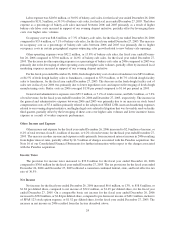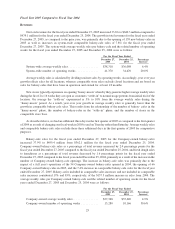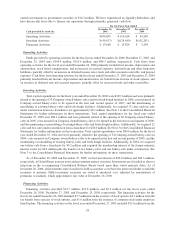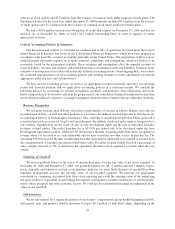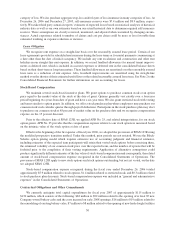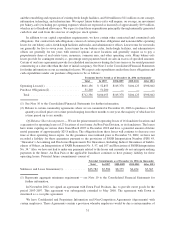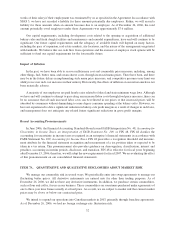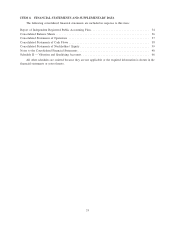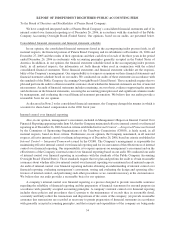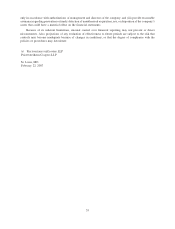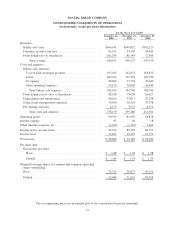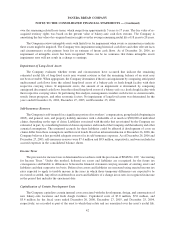Panera Bread 2006 Annual Report Download - page 37
Download and view the complete annual report
Please find page 37 of the 2006 Panera Bread annual report below. You can navigate through the pages in the report by either clicking on the pages listed below, or by using the keyword search tool below to find specific information within the annual report.weeks of their salary if their employment was terminated by us as specified in the Agreement. In accordance with
SFAS 5, we have not recorded a liability for these amounts potentially due employees. Rather, we will record a
liability for these amounts when an amount becomes due to an employee. As of December 26, 2006, the total
amount potentially owed employees under these Agreements was approximately $7.6 million.
Our capital requirements, including development costs related to the opening or acquisition of additional
bakery-cafes and fresh dough facilities and maintenance and remodel expenditures, have and will continue to be
significant. Our future capital requirements and the adequacy of available funds will depend on many factors,
including the pace of expansion, real estate markets, site locations, and the nature of the arrangements negotiated
with landlords. We believe that our cash flow from operations and the exercise of employee stock options will be
sufficient to fund our capital requirements for the foreseeable future.
Impact of Inflation
In the past, we have been able to recover inflationary cost and commodity price increases, including, among
other things, fuel, butter, tuna, and cream cheese costs, through increased menu prices. There have been, and there
may be in the future, delays in implementing such menu price increases, and competitive pressures may limit our
ability to recover such cost increases in their entirety. Historically, the effects of inflation on our net income have not
been materially adverse.
A majority of our employees are paid hourly rates related to federal and state minimum wage laws. Although
we have and will continue to attempt to pass along any increased labor costs through food price increases, there can
be no assurance that all such increased labor costs can be reflected in our prices or that increased prices will be
absorbed by consumers without diminishing to some degree consumer spending at the bakery-cafes. However, we
have not experienced to date a significant reduction in bakery-cafe profit margins as a result of changes in such laws,
and management does not anticipate any related future significant reductions in gross profit margins.
Recent Accounting Pronouncements
In June 2006, the Financial Accounting Standards Board issued FASB Interpretation No. 48, Accounting for
Uncertainty in Income Taxes, an interpretation of FASB Statement No. 109, or FIN 48. FIN 48 clarifies the
accounting for uncertainty in income taxes recognized in an enterprise’s financial statements in accordance with
FASB Statement No. 109, Accounting for Income Taxes. FIN 48 prescribes a recognition threshold and measure-
ment attribute for the financial statement recognition and measurement of a tax position taken or expected to be
taken in a tax return. This pronouncement also provides guidance on derecognition, classification, interest and
penalties, accounting in interim periods, disclosure, and transition. FIN 48 is effective for fiscal years beginning
after December 15, 2006; therefore, we will adopt the new requirements for fiscal 2007. We are evaluating the effect
of this pronouncement on our consolidated financial statements.
ITEM 7A. QUANTITATIVE AND QUALITATIVE DISCLOSURES ABOUT MARKET RISK
We manage our commodity risk in several ways. We periodically enter into swap agreements to manage our
fluctuating butter prices. All derivative instruments are entered into for other than trading purposes. As of
December 26, 2006, we did not have any derivative instruments. In addition, we purchase certain commodities,
such as flour and coffee, for use in our business. These commodities are sometimes purchased under agreements of
one to three year time frames usually at a fixed price. As a result, we are subject to market risk that current market
prices may be above or below our contractual price.
We intend to expand our operations into Canadian markets in 2007, primarily through franchise agreements.
As of December 26, 2006, we had no foreign exchange rate fluctuation risk.
32




